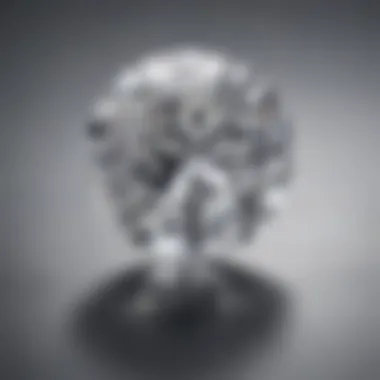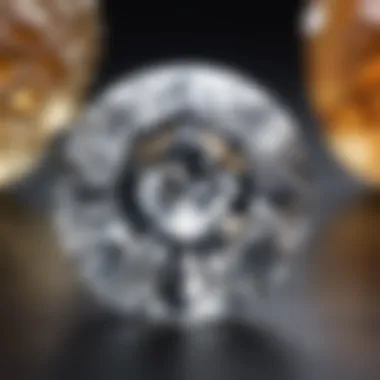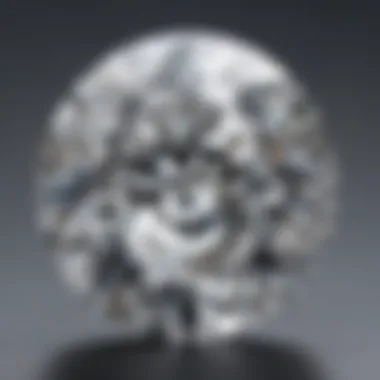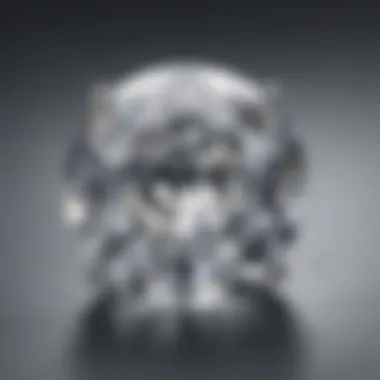An In-Depth Analysis of 3 Carat White Sapphires


Intro
The world of gemstones is vast and often complex, yet few gems capture the attention of enthusiasts like the 3 carat white sapphire. As this article unfolds, it delves into the multiple facets of this captivating stone. From its defining characteristics to its historical significance and contemporary market trends, the intention is to provide a thorough understanding for both collectors and casual admirers.
Gemstone Overview
Definition and Characteristics
White sapphires are a variety of corundum, which is the same mineral that produces the more widely known ruby and sapphire gemstones. The stunning clarity and brilliance of these stones make them an appealing alternative to diamonds for jewelry. Typically, a 3 carat white sapphire will exhibit good transparency and a range of subtle hues, although they are often sought after for their colorless appearance.
Some defining characteristics of 3 carat white sapphires include:
- Hardness: White sapphires rank a 9 on the Mohs scale, which makes them highly durable and suitable for everyday wear.
- Rarity: Though not as common as other gemstones, fine quality white sapphires, especially at 3 carats, can be relatively rare.
- Refractive Index: The refractive index ranges between 1.76 and 1.77, contributing to their brilliant sparkle.
Classification of Gemstones
Gemstones fall into various categories primarily distinguished by their mineral composition. Generally, gems are classified into precious and semi-precious stones. While traditional classifications placed diamonds, rubies, emeralds, and sapphires in the precious category, the beauty and durability of white sapphires merit their consideration among gemstones of high value.
Moreover, white sapphires can be further categorized based on their origin:
- Natural: Gemstones mined directly from the earth.
- Synthetic: Created in laboratories with physical and chemical properties identical to natural stones.
- Enhanced: Treated to improve clarity or color, although such processes must be disclosed when sold.
Historical Significance
Ancient Uses and Cultural Importance
Historically, sapphires have been revered across various cultures. In ancient Persia, for example, it was believed that the earth rested on a giant sapphire, reflecting the sky’s color. White sapphires, while not as well documented in history as their colored counterparts, have still held significance in different societies for their beauty and perceived protective properties. In some cultures, they were associated with wisdom and nobility.
Myths and Legends Surrounding Gemstones
Legends surrounding sapphires often speak to their power and influence. White sapphires, like other gemstones, have been surrounded by numerous myths. Some believe they bring clarity of thought and good fortune to their wearers. In the realm of jewelry, they are often set to enhance spirituality and emotional depth, echoing the sentiments attributed to their colored relatives.
"White sapphires have symbolized wisdom and protection throughout history, making them not just ornaments but also tokens of deeper meaning."
In summary, the 3 carat white sapphire presents an intriguing subject worth exploring deeply. This analysis will focus on its characteristics, sourcing, and uses in the jewelry market.
Intro to White Sapphires
White sapphires have garnered attention in the gemstone world for their unique beauty and versatility. They serve as an alternative to traditional diamonds, alluring many gem enthusiasts and buyers. Their appeal lies not only in their clarity and color but also in their significance in various jewelry designs. Understanding white sapphires extends beyond mere aesthetics; it involves comprehending their geological characteristics, market dynamics, and the craftsmanship involved in transforming raw stones into exquisite pieces.
This introduction sets the stage for a thorough exploration of white sapphires, particularly the 3 carat variety, highlighting their intrinsic properties and the external factors that influence their valuation. These insights benefit collectors, designers, and investors who plan to engage with the gemstone market.
Defining White Sapphire
White sapphires are a type of the mineral corundum, similar to rubies and blue sapphires. Unlike other sapphires which display vivid colors due to trace elements, white sapphires remain colorless. Their appearance resembles that of a diamond but without the high price tag. This unique characteristic makes them increasingly popular in jewelry, particularly in engagement rings and other fine adornments.
The gem's clarity is significant, as it determines its brilliance and visual appeal. High-quality white sapphires exhibit no internal inclusions and have a brilliance that can rival that of diamonds. However, they lack the hardness of some gemstones, emphasizing the balance between beauty and durability.


The Role of Carat in Gemstones
Carat is a crucial measure in the gemstone industry. It refers to the weight of the gemstone, with one carat equal to 200 milligrams. The weight influences the value of the stone considerably. For white sapphires, a 3 carat stone often commands a higher price due to its rarity and allure.
Higher carats ensure larger stones provide visual impact, appealing to buyers looking for statement pieces. However, it is essential to note that carat alone does not determine a gemstone's overall quality. Clarity, cut, and color also play significant roles in valuation. Therefore, when assessing a gemstone, a comprehensive evaluation based on these criteria provides a clearer picture of its desirability and market worth.
Origin and Formation of White Sapphires
Understanding the origin and formation of white sapphires is crucial in appreciating their uniqueness and value in the gemstone market. White sapphires, despite their common appearance, form under specific geological conditions that contribute to their distinctive characteristics. This section will delve into these conditions and the geographical sources of these gemstones, offering valuable insights for enthusiasts, collectors, and professionals alike.
Geological Conditions for Formation
White sapphires, classified as corundum crystals, require particular geological circumstances for their formation. The processes involved are complex and time-consuming, taking millions of years to yield the finished stone. Generally, these gemstones form deep within the Earth’s crust, which provides an environment rich in aluminum. The necessary temperatures range between 1,600 to 2,000 degrees Celsius, under intense pressure conditions.
Key factors in the formation include:
- Heat and Pressure: These elements play an essential role, allowing the crystal structure to develop correctly. Higher pressures create denser and clearer sapphires.
- Chemical Elements: Besides aluminum, the presence of trace minerals influences the stone’s clarity and color. White sapphires are primarily devoid of significant impurities, which is why clarity becomes a prominent feature.
- Time: The geological time scale significantly impacts the formation process. The longer the time of crystallization, the more refined the structure of the sapphire.
These conditions lead to the development of sapphires that are not only beautiful but also valuable in various applications, like jewelry.
Mining Locations for White Sapphires
Identifying where white sapphires are mined adds another layer of understanding to their origin. Not all mines produce sapphires of equal quality. The most notable mining locations include:
- Sri Lanka: This island nation is renowned for its high-quality white sapphires, formed under ideal geological circumstances.
- Australia: Known for producing various colorations of sapphires, Australia also mines significant quantities of white sapphires.
- Montana, USA: Montana is famous for its unique gemstones. White sapphires from this region often exhibit exceptional clarity, making them sought after.
- Thailand: Thailand has some history in sapphire production, with many gems originating from this region.
The specific location impacts the overall quality, clarity, and even market price of white sapphires. Available certifications often indicate the origin, serving as an assurance of where the gemstone was sourced. For those interested in the investment potential of sapphires, understanding these mining locations is essential.
Characteristics of Carat White Sapphires
The examination of characteristics specific to 3 carat white sapphires provides crucial insights that resonate with enthusiasts and collectors alike. This section addresses key elements such as clarity, hardness, and spectrum comparison with other stones. Understanding these attributes allows potential buyers to make informed decisions, enhances appreciation for the gem, and elucidates its standing in the marketplace.
Clarity and Color Analysis
Clarity is a significant factor in determining the quality of a sapphire. For 3 carat white sapphires, clarity is often influenced by the presence of inclusions, which can detract from their overall appearance. High-quality specimens are typically transparent with minimal visible flaws. Most jewelers strive for stones that achieve at least the VS (Very Slightly Included) grade, ensuring that any inclusions are not evident to the naked eye.
It is also important to consider that while the primary hue of a sapphire is white, it can exhibit subtle color variations. These may include hints of yellow or gray. Such undertones can affect the aesthetic and, consequently, the value of the sapphire. Evaluating clarity and saturation offers deeper understanding about how these factors interplay in establishing the stone's desirability.
Hardness and Durability
White sapphires are acclaimed for their exceptional hardness, rated at 9 on the Mohs scale. This attribute makes them not only resilient but also suitable for daily wear in jewelry such as rings and bracelets. Unlike softer gemstones, 3 carat white sapphires resist scratches and maintain their luster over time.
Durability is a paramount concern for consumers, especially for those seeking investment pieces. Proper care can further enhance the longevity of these stones. Furthermore, understanding hardness within the broader context of other gemstones emphasizes the practicality of selecting white sapphires for functional jewelry.
Comparative Spectrum with Other Stones
Understanding where white sapphires stand in relation to other popular stones is vital for discerning buyers. For instance, they often compete with diamonds due to their similar appearance. However, diamonds score a perfect 10 on the Mohs scale, making them a slightly harder choice. In contrast, white sapphires offer a more affordable alternative with similar looks.


When comparing white sapphires to cubic zirconia, one can note distinct differences in brilliance and durability. While cubic zirconia may appear perfectly flawless, it lacks the natural charm inherent to white sapphires. Identifying these contrasts aids in comprehending the unique selling proposition of white sapphires—as not just alternatives, but as genuine gems with their own intrinsic value.
Understanding the clarity, hardness, and comparative value of these stones enriches knowledge and appreciation for their place in the market.
Market Trends for White Sapphires
Market trends for white sapphires play a significant role in determining the overall appeal and viability of this gemstone, especially in an industry driven by consumer preference and economic factors. Understanding these trends can benefit those considering investments, jewelry design, or simply an interest in white sapphires. This section will delve into current valuation and pricing, the dynamics between demand and supply, and the role of certification in establishing market value.
Current Valuation and Pricing
The valuation of 3 carat white sapphires is influenced by several factors, including clarity, cut, and color. As a general guideline, the price for a high-quality white sapphire can range significantly, often falling between $100 to $1,500 per carat. Factors that can modify this range include:
- Clarity: Higher clarity stones usually command better prices.
- Color Grading: Although white sapphires are colorless, slight variations may affect valuation.
- Cut Quality: A well-cut stone enhances visual appeal, impacting market price.
"Understanding the current market valuation is crucial for both buyers and sellers. It helps set realistic expectations in transactions."
In recent years, there has been a noticeable increase in consumer interest in alternative gemstones. This has led to a sense of rising value as white sapphires are often considered as a more economical choice compared to diamond alternatives.
Demand versus Supply Dynamics
The white sapphire market is characterized by fluctuating demand and supply dynamics. On one hand, growing interest in ethically sourced and sustainable gemstones has driven demand for white sapphires. On the other hand, the supply is relatively stable due to established mining locations in countries like Sri Lanka, Madagascar, and Australia. The key elements influencing this balance are:
- Consumer Preference: As consumers lean towards sustainable choices, the demand for white sapphires increases.
- Limited Mining: While supply is steady, it is not increasing rapidly, which can create value.
- Market Awareness: Enhanced knowledge about gemstones encourages buyer interest, impacting demand positively.
Role of Certification in Market Value
Certification plays a vital role in validating the quality of white sapphires. Reputable certifying bodies, such as the Gemological Institute of America (GIA) and the International Gemological Institute (IGI), provide essential insights into a gemstone's quality and authenticity. A certified stone generally holds a higher market value due to:
- Trust: Buyers feel more secure knowing the gem has been assessed by experts.
- Transparency: Certification details the stone’s characteristics, ensuring that buyers know exactly what they are purchasing.
- Value Assessment: Certified stones often lead to more accurate pricing in the marketplace as they provide a benchmark for comparisons.
understanding the market trends for white sapphires is not just beneficial but essential for anyone engaged in this fascinating industry. The insights gained from current valuations, demand-supply dynamics, and the impacts of certification can guide informed decisions, enhancing one's experience with this unique gemstone.
Applications of Carat White Sapphire
The applications of 3 carat white sapphires extend beyond their aesthetic allure. This section aims to highlight not only their significance in jewelry design but also their rising potential as a financial investment. Both elements work to underscore the multifaceted value of this gemstone in today's market.
Jewelry Design Trends
The jewelry industry continually evolves, and sapphires have made a notable entrance in recent design trends. A 3 carat white sapphire stands out due to its clarity and brilliance. Its versatility allows it to seamlessly swap with diamonds in various settings, giving designers more options to appeal to modern sensibilities.
One major trend is the shift towards sustainable and ethically sourced gemstones. Buyers are increasingly interested in the origins of their purchases, leading to greater demand for sapphires mined with a focus on environmentally responsible practices.
Additionally, customized jewelry is gaining traction. Consumers desire pieces that reflect their individual tastes and stories. A 3 carat white sapphire offers substantial presence for custom rings, earrings, or pendants. Enhanced with unique settings, it draws attention while exuding elegance. Jewelers now frequently combine white sapphires with alternative materials, such as rose gold or intricate metalwork, to create standout pieces.
Key Jewelry Design Considerations:
- Color-Matching: White sapphires complement a range of materials and skin tones, making them adaptable.
- Design Versatility: They are ideal for both classic and contemporary designs.
- Customizations: More buyers are opting for personalized styles, further enhancing demand.


Investment Potential
Investing in gemstones, particularly 3 carat white sapphires, is becoming more common as collectors and enthusiasts seek to diversify their portfolios. The potential for appreciation in value is considerable, given the right conditions.
Unlike diamonds, which can be subject to inflated prices driven by branding, white sapphires offer a more abundant alternative without sacrificing quality. Their market remains stable, driven by both fashion trends and discerning buyers seeking unique investment opportunities.
A few factors influence the investment outlook for white sapphires:
- Market Liquidity: There is a growing interest in buy-sell platforms where white sapphires are traded, increasing potential liquidity for investors.
- Quality and Certification: Established certifications confer authenticity and quality assurance, making them more attractive to investors.
- Historical Performance: Analysis of past market trends indicates a steady increase in interest and prices for white sapphires over time.
In summary, the applications of 3 carat white sapphires encompass both jewelry design and investment avenues. Understanding these elements can furnish buyers, designers, and investors with critical knowledge to navigate the industry's evolving landscape. White sapphires are not just gems; they are versatile tools for aesthetic expression and financial growth.
"Sapphires are gaining recognition not just for beauty, but as a smart investment for the future."
By keeping track of these trends, individuals can better position themselves to make informed decisions in an increasingly competitive market.
Caring for White Sapphires
Caring for white sapphires is essential for maintaining their brilliance and value. This management involves understanding how to clean and store these gemstones properly. Like any significant gemstone, white sapphires can be affected by dirt, grime, and scratches. Their clarity and aesthetic appeal can diminish over time if proper measures are not taken. Thus, adopting effective care routines is vital for anyone who owns or works with these stones. In this section, we will delve into appropriate cleaning practices and storage solutions that protect and preserve the integrity of white sapphires.
Cleaning Best Practices
Cleaning white sapphires requires a gentle approach to avoid damaging their surface. The following best practices are effective:
- Use Mild Soap: A mixture of warm water and mild liquid soap works well. This combination is gentle enough to clean without causing harm.
- Soft Brush: Employ a soft-bristled brush, such as a toothbrush. This brush helps remove grime stuck in crevices without scratching the gemstone.
- Rinse Thoroughly: After cleaning, rinse the gemstone well under lukewarm water. Ensuring that no soap residue remains is crucial.
- Dry Gently: Use a soft, lint-free cloth to dry the stone. Patting gently is better than wiping, as rubbing could cause scratches.
Following these methods helps maintain the shine and clarity of white sapphires, prolonging their appeal and value.
Storage Considerations
Proper storage is crucial to protect white sapphires from physical damage. Here are some effective tips for storing these gemstones safely:
- Separate Storage: Always store white sapphires separately from other jewelry pieces. This practice prevents scraping and scratching.
- Use Soft Pouches or Boxes: Keeping them in a soft pouch or a padded box reduces exposure to dust and minimizes the chance of damage.
- Avoid Direct Sunlight: Store sapphires away from direct sunlight and extreme temperatures. Prolonged exposure can alter their appearance and structural integrity.
In summary, taking the time to care for white sapphires through proper cleaning and storage practices will ensure they maintain their beauty and value for years. The methods outlined here are simple yet effective, suitable for both casual enthusiasts and serious collectors.
Future Outlook for White Sapphires
The future outlook for white sapphires is crucial in comprehending their long-term potential in the gemstone market. As consumer preferences evolve, various factors will influence demand, pricing, and overall market perception of these gemstones. Understanding these dynamics can help stakeholders, including retailers, investors, and jewelry designers, make informed decisions.
Market Predictions
Analysts suggest that the market for white sapphires will grow steadily in the upcoming years. Several reasons support this forecast:
- Increased Awareness: As knowledge grows about the differences between white sapphires and diamonds, more consumers may choose white sapphires for their unique characteristics.
- Sustainability Concerns: The ethical sourcing of gemstones is increasingly important to consumers. White sapphires, often lab-created, can be an appealing choice for those looking to make environmentally friendly decisions.
- Price Point: White sapphires typically cost less than their diamond counterparts. This attractive pricing can draw price-sensitive buyers seeking quality alternatives.
Considering these factors, the expectation is that demand for white sapphires will rise. However, market fluctuations can occur due to changes in consumer trends, global economic conditions, and sourcing challenges. Stakeholders should closely monitor these elements to adjust their strategies accordingly.
Emerging Trends
Emerging trends within the gemstone industry will also shape the future for white sapphires. Notable trends include:
- Customization in Jewelry Design: Consumers increasingly seek personalized pieces, leading to greater demand for white sapphires in bespoke jewelry. Designers are experimenting with various styles, incorporating white sapphires into unique settings that enhance their natural beauty.
- Increasing Online Sales: The shift toward online shopping has changed how gemstones are marketed and sold. White sapphires are gaining attention through digital platforms that showcase their qualities and benefits. This accessibility may widen the customer base.
- Popularity in Celebrity Culture: With celebrities showcasing white sapphires in their jewelry collections, public interest may rise further. This exposure can influence consumer choices, leading to increased sales.







